Psychology Assignment: Research Methods, Analysis, and Ethics
VerifiedAdded on 2021/10/13
|7
|1786
|590
Homework Assignment
AI Summary
This psychology assignment explores various research methods used in psychological analysis, including unstructured interviews and case studies. The assignment delves into the strengths and weaknesses of unstructured interviews, emphasizing flexibility and data generation, while also acknowledging their time-consuming nature and high interviewer training costs. It examines the importance of training interviewers to ensure high-quality data collection and discusses the application of case studies, focusing on stress among students in academically challenging programs and the generalizability of the results. The assignment also covers data triangulation for credibility, systematic sampling, and ethical considerations, including informed consent and the potential for research bias. Finally, it evaluates the use of interviews in gathering in-depth information and provides a comprehensive overview of the research process.
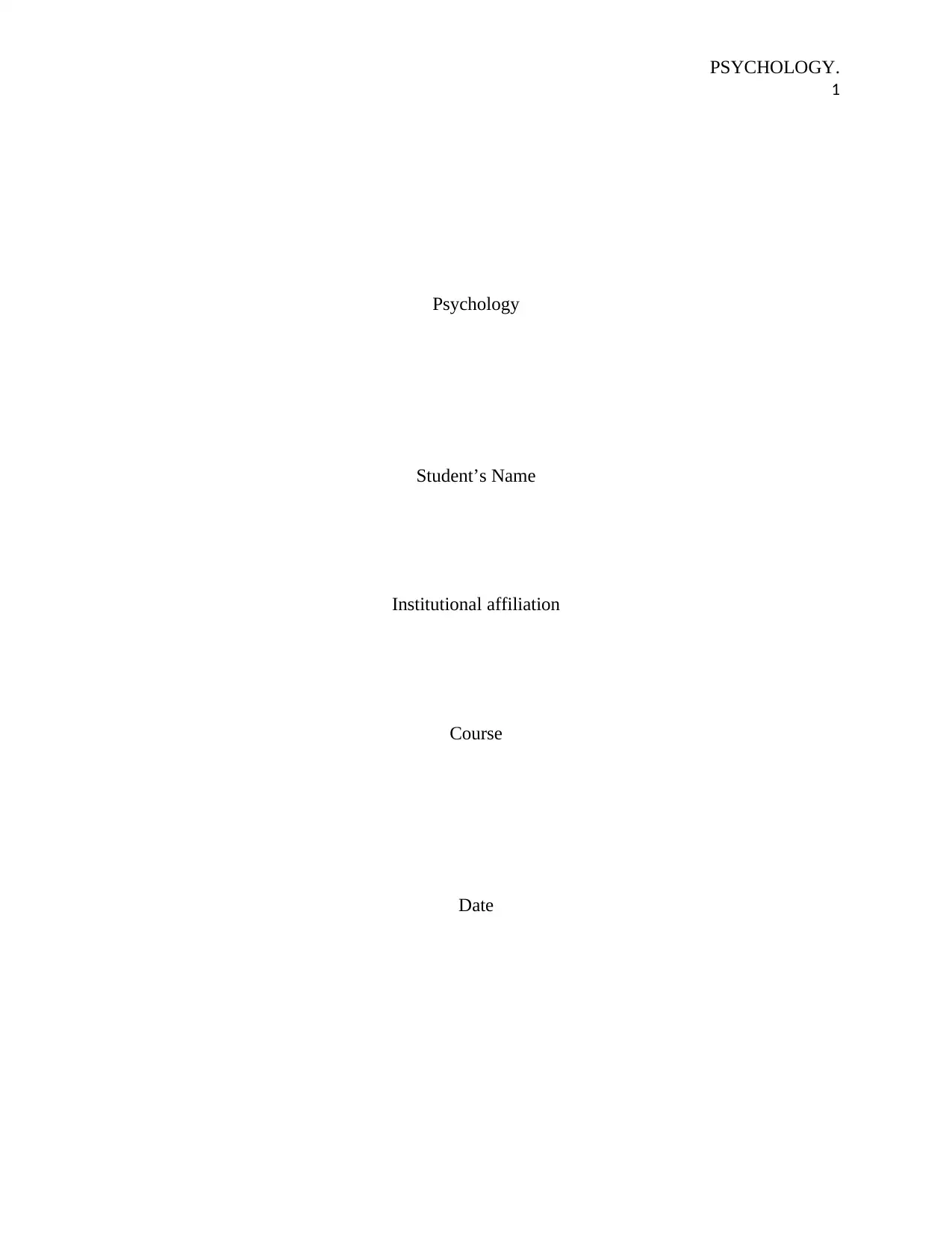
PSYCHOLOGY.
1
Psychology
Student’s Name
Institutional affiliation
Course
Date
1
Psychology
Student’s Name
Institutional affiliation
Course
Date
Paraphrase This Document
Need a fresh take? Get an instant paraphrase of this document with our AI Paraphraser
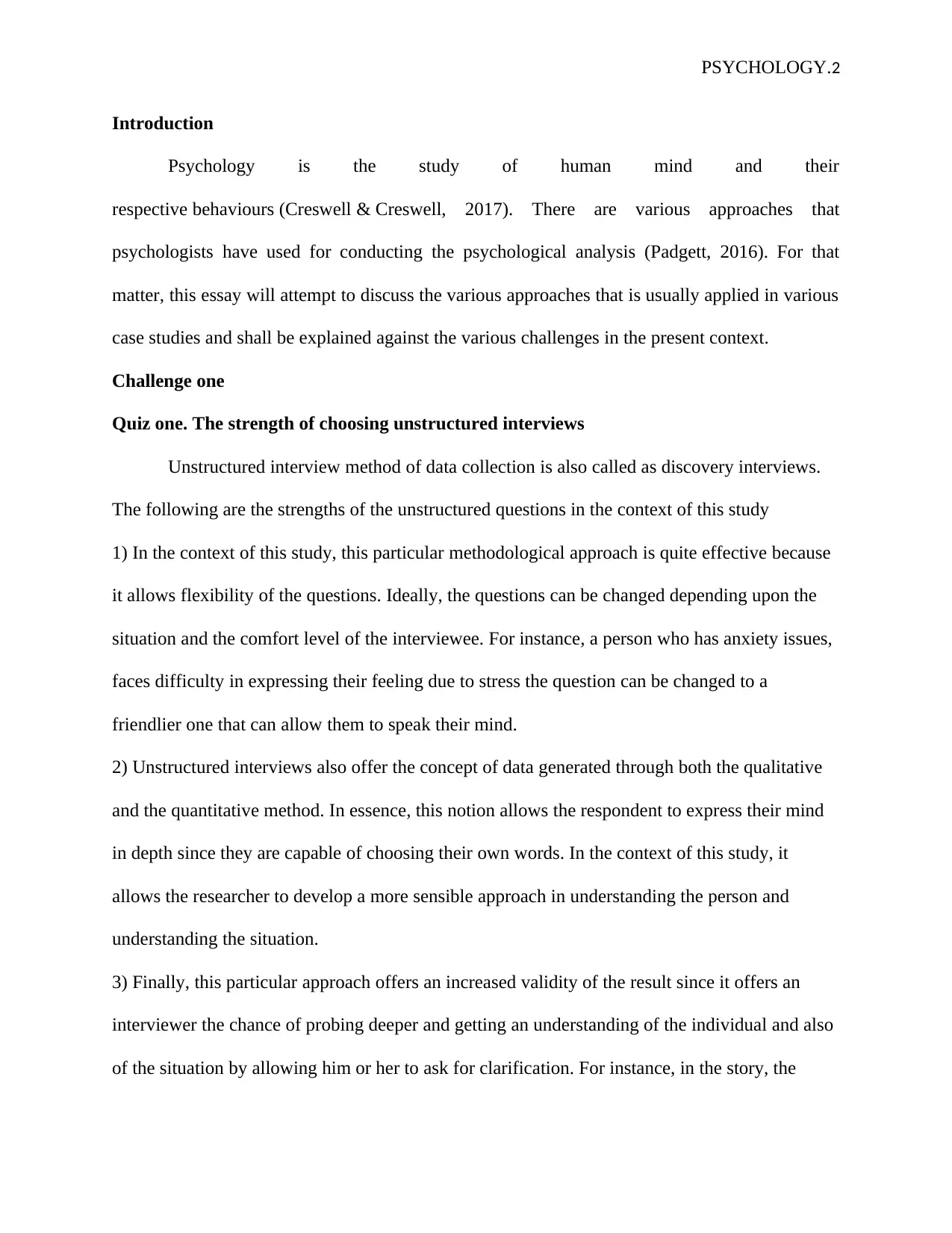
PSYCHOLOGY.2
Introduction
Psychology is the study of human mind and their
respective behaviours (Creswell & Creswell, 2017). There are various approaches that
psychologists have used for conducting the psychological analysis (Padgett, 2016). For that
matter, this essay will attempt to discuss the various approaches that is usually applied in various
case studies and shall be explained against the various challenges in the present context.
Challenge one
Quiz one. The strength of choosing unstructured interviews
Unstructured interview method of data collection is also called as discovery interviews.
The following are the strengths of the unstructured questions in the context of this study
1) In the context of this study, this particular methodological approach is quite effective because
it allows flexibility of the questions. Ideally, the questions can be changed depending upon the
situation and the comfort level of the interviewee. For instance, a person who has anxiety issues,
faces difficulty in expressing their feeling due to stress the question can be changed to a
friendlier one that can allow them to speak their mind.
2) Unstructured interviews also offer the concept of data generated through both the qualitative
and the quantitative method. In essence, this notion allows the respondent to express their mind
in depth since they are capable of choosing their own words. In the context of this study, it
allows the researcher to develop a more sensible approach in understanding the person and
understanding the situation.
3) Finally, this particular approach offers an increased validity of the result since it offers an
interviewer the chance of probing deeper and getting an understanding of the individual and also
of the situation by allowing him or her to ask for clarification. For instance, in the story, the
Introduction
Psychology is the study of human mind and their
respective behaviours (Creswell & Creswell, 2017). There are various approaches that
psychologists have used for conducting the psychological analysis (Padgett, 2016). For that
matter, this essay will attempt to discuss the various approaches that is usually applied in various
case studies and shall be explained against the various challenges in the present context.
Challenge one
Quiz one. The strength of choosing unstructured interviews
Unstructured interview method of data collection is also called as discovery interviews.
The following are the strengths of the unstructured questions in the context of this study
1) In the context of this study, this particular methodological approach is quite effective because
it allows flexibility of the questions. Ideally, the questions can be changed depending upon the
situation and the comfort level of the interviewee. For instance, a person who has anxiety issues,
faces difficulty in expressing their feeling due to stress the question can be changed to a
friendlier one that can allow them to speak their mind.
2) Unstructured interviews also offer the concept of data generated through both the qualitative
and the quantitative method. In essence, this notion allows the respondent to express their mind
in depth since they are capable of choosing their own words. In the context of this study, it
allows the researcher to develop a more sensible approach in understanding the person and
understanding the situation.
3) Finally, this particular approach offers an increased validity of the result since it offers an
interviewer the chance of probing deeper and getting an understanding of the individual and also
of the situation by allowing him or her to ask for clarification. For instance, in the story, the
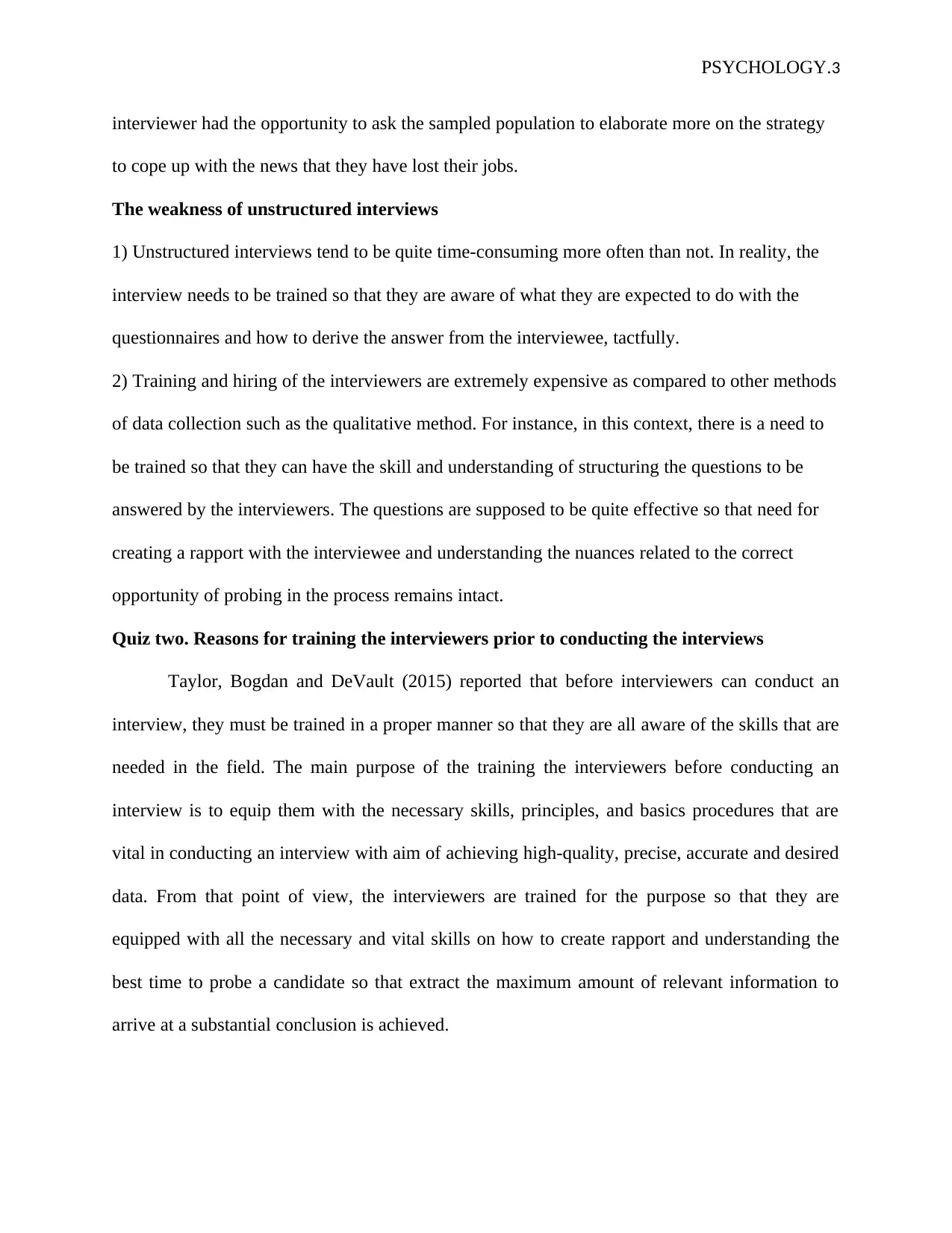
PSYCHOLOGY.3
interviewer had the opportunity to ask the sampled population to elaborate more on the strategy
to cope up with the news that they have lost their jobs.
The weakness of unstructured interviews
1) Unstructured interviews tend to be quite time-consuming more often than not. In reality, the
interview needs to be trained so that they are aware of what they are expected to do with the
questionnaires and how to derive the answer from the interviewee, tactfully.
2) Training and hiring of the interviewers are extremely expensive as compared to other methods
of data collection such as the qualitative method. For instance, in this context, there is a need to
be trained so that they can have the skill and understanding of structuring the questions to be
answered by the interviewers. The questions are supposed to be quite effective so that need for
creating a rapport with the interviewee and understanding the nuances related to the correct
opportunity of probing in the process remains intact.
Quiz two. Reasons for training the interviewers prior to conducting the interviews
Taylor, Bogdan and DeVault (2015) reported that before interviewers can conduct an
interview, they must be trained in a proper manner so that they are all aware of the skills that are
needed in the field. The main purpose of the training the interviewers before conducting an
interview is to equip them with the necessary skills, principles, and basics procedures that are
vital in conducting an interview with aim of achieving high-quality, precise, accurate and desired
data. From that point of view, the interviewers are trained for the purpose so that they are
equipped with all the necessary and vital skills on how to create rapport and understanding the
best time to probe a candidate so that extract the maximum amount of relevant information to
arrive at a substantial conclusion is achieved.
interviewer had the opportunity to ask the sampled population to elaborate more on the strategy
to cope up with the news that they have lost their jobs.
The weakness of unstructured interviews
1) Unstructured interviews tend to be quite time-consuming more often than not. In reality, the
interview needs to be trained so that they are aware of what they are expected to do with the
questionnaires and how to derive the answer from the interviewee, tactfully.
2) Training and hiring of the interviewers are extremely expensive as compared to other methods
of data collection such as the qualitative method. For instance, in this context, there is a need to
be trained so that they can have the skill and understanding of structuring the questions to be
answered by the interviewers. The questions are supposed to be quite effective so that need for
creating a rapport with the interviewee and understanding the nuances related to the correct
opportunity of probing in the process remains intact.
Quiz two. Reasons for training the interviewers prior to conducting the interviews
Taylor, Bogdan and DeVault (2015) reported that before interviewers can conduct an
interview, they must be trained in a proper manner so that they are all aware of the skills that are
needed in the field. The main purpose of the training the interviewers before conducting an
interview is to equip them with the necessary skills, principles, and basics procedures that are
vital in conducting an interview with aim of achieving high-quality, precise, accurate and desired
data. From that point of view, the interviewers are trained for the purpose so that they are
equipped with all the necessary and vital skills on how to create rapport and understanding the
best time to probe a candidate so that extract the maximum amount of relevant information to
arrive at a substantial conclusion is achieved.
⊘ This is a preview!⊘
Do you want full access?
Subscribe today to unlock all pages.

Trusted by 1+ million students worldwide
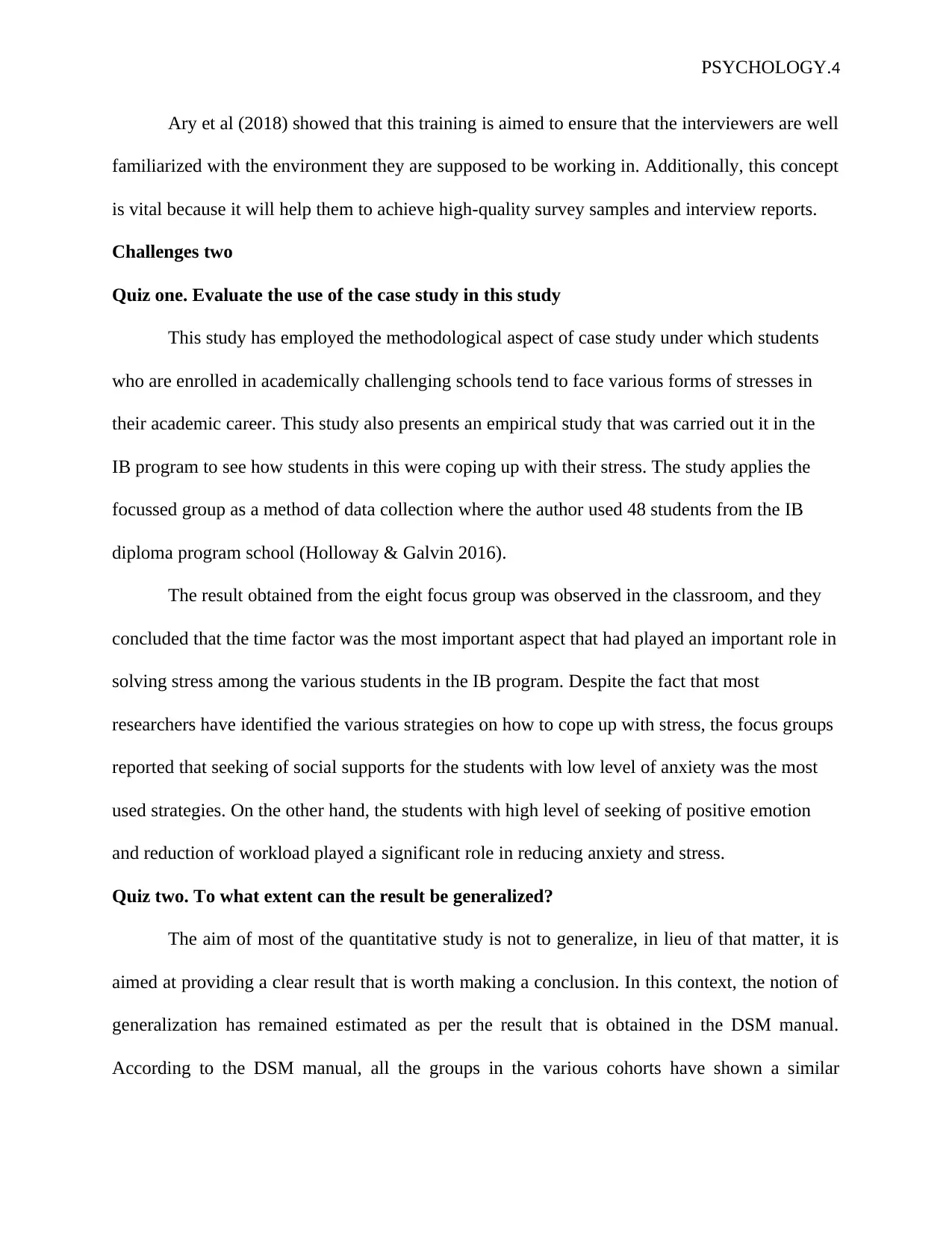
PSYCHOLOGY.4
Ary et al (2018) showed that this training is aimed to ensure that the interviewers are well
familiarized with the environment they are supposed to be working in. Additionally, this concept
is vital because it will help them to achieve high-quality survey samples and interview reports.
Challenges two
Quiz one. Evaluate the use of the case study in this study
This study has employed the methodological aspect of case study under which students
who are enrolled in academically challenging schools tend to face various forms of stresses in
their academic career. This study also presents an empirical study that was carried out it in the
IB program to see how students in this were coping up with their stress. The study applies the
focussed group as a method of data collection where the author used 48 students from the IB
diploma program school (Holloway & Galvin 2016).
The result obtained from the eight focus group was observed in the classroom, and they
concluded that the time factor was the most important aspect that had played an important role in
solving stress among the various students in the IB program. Despite the fact that most
researchers have identified the various strategies on how to cope up with stress, the focus groups
reported that seeking of social supports for the students with low level of anxiety was the most
used strategies. On the other hand, the students with high level of seeking of positive emotion
and reduction of workload played a significant role in reducing anxiety and stress.
Quiz two. To what extent can the result be generalized?
The aim of most of the quantitative study is not to generalize, in lieu of that matter, it is
aimed at providing a clear result that is worth making a conclusion. In this context, the notion of
generalization has remained estimated as per the result that is obtained in the DSM manual.
According to the DSM manual, all the groups in the various cohorts have shown a similar
Ary et al (2018) showed that this training is aimed to ensure that the interviewers are well
familiarized with the environment they are supposed to be working in. Additionally, this concept
is vital because it will help them to achieve high-quality survey samples and interview reports.
Challenges two
Quiz one. Evaluate the use of the case study in this study
This study has employed the methodological aspect of case study under which students
who are enrolled in academically challenging schools tend to face various forms of stresses in
their academic career. This study also presents an empirical study that was carried out it in the
IB program to see how students in this were coping up with their stress. The study applies the
focussed group as a method of data collection where the author used 48 students from the IB
diploma program school (Holloway & Galvin 2016).
The result obtained from the eight focus group was observed in the classroom, and they
concluded that the time factor was the most important aspect that had played an important role in
solving stress among the various students in the IB program. Despite the fact that most
researchers have identified the various strategies on how to cope up with stress, the focus groups
reported that seeking of social supports for the students with low level of anxiety was the most
used strategies. On the other hand, the students with high level of seeking of positive emotion
and reduction of workload played a significant role in reducing anxiety and stress.
Quiz two. To what extent can the result be generalized?
The aim of most of the quantitative study is not to generalize, in lieu of that matter, it is
aimed at providing a clear result that is worth making a conclusion. In this context, the notion of
generalization has remained estimated as per the result that is obtained in the DSM manual.
According to the DSM manual, all the groups in the various cohorts have shown a similar
Paraphrase This Document
Need a fresh take? Get an instant paraphrase of this document with our AI Paraphraser
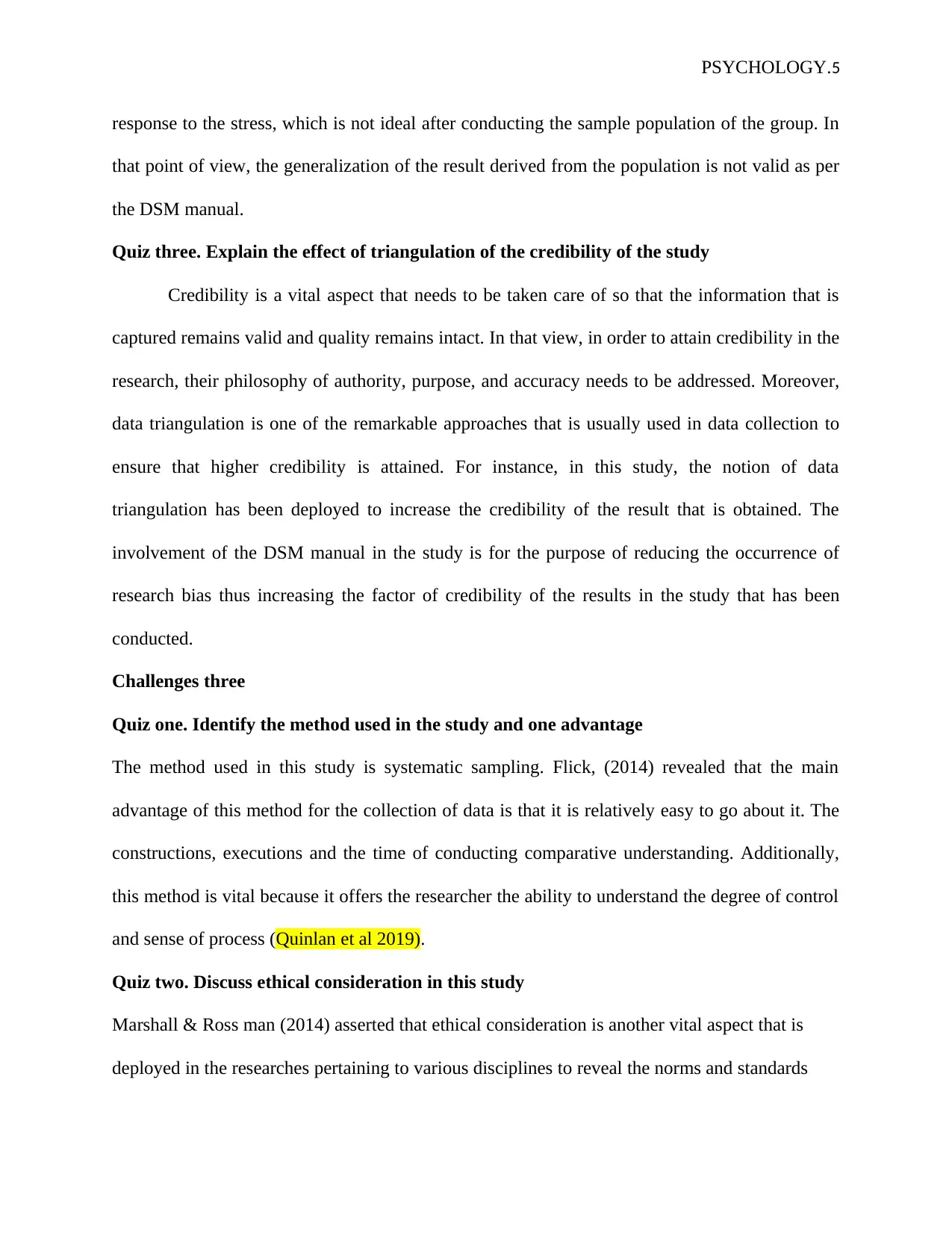
PSYCHOLOGY.5
response to the stress, which is not ideal after conducting the sample population of the group. In
that point of view, the generalization of the result derived from the population is not valid as per
the DSM manual.
Quiz three. Explain the effect of triangulation of the credibility of the study
Credibility is a vital aspect that needs to be taken care of so that the information that is
captured remains valid and quality remains intact. In that view, in order to attain credibility in the
research, their philosophy of authority, purpose, and accuracy needs to be addressed. Moreover,
data triangulation is one of the remarkable approaches that is usually used in data collection to
ensure that higher credibility is attained. For instance, in this study, the notion of data
triangulation has been deployed to increase the credibility of the result that is obtained. The
involvement of the DSM manual in the study is for the purpose of reducing the occurrence of
research bias thus increasing the factor of credibility of the results in the study that has been
conducted.
Challenges three
Quiz one. Identify the method used in the study and one advantage
The method used in this study is systematic sampling. Flick, (2014) revealed that the main
advantage of this method for the collection of data is that it is relatively easy to go about it. The
constructions, executions and the time of conducting comparative understanding. Additionally,
this method is vital because it offers the researcher the ability to understand the degree of control
and sense of process (Quinlan et al 2019).
Quiz two. Discuss ethical consideration in this study
Marshall & Ross man (2014) asserted that ethical consideration is another vital aspect that is
deployed in the researches pertaining to various disciplines to reveal the norms and standards
response to the stress, which is not ideal after conducting the sample population of the group. In
that point of view, the generalization of the result derived from the population is not valid as per
the DSM manual.
Quiz three. Explain the effect of triangulation of the credibility of the study
Credibility is a vital aspect that needs to be taken care of so that the information that is
captured remains valid and quality remains intact. In that view, in order to attain credibility in the
research, their philosophy of authority, purpose, and accuracy needs to be addressed. Moreover,
data triangulation is one of the remarkable approaches that is usually used in data collection to
ensure that higher credibility is attained. For instance, in this study, the notion of data
triangulation has been deployed to increase the credibility of the result that is obtained. The
involvement of the DSM manual in the study is for the purpose of reducing the occurrence of
research bias thus increasing the factor of credibility of the results in the study that has been
conducted.
Challenges three
Quiz one. Identify the method used in the study and one advantage
The method used in this study is systematic sampling. Flick, (2014) revealed that the main
advantage of this method for the collection of data is that it is relatively easy to go about it. The
constructions, executions and the time of conducting comparative understanding. Additionally,
this method is vital because it offers the researcher the ability to understand the degree of control
and sense of process (Quinlan et al 2019).
Quiz two. Discuss ethical consideration in this study
Marshall & Ross man (2014) asserted that ethical consideration is another vital aspect that is
deployed in the researches pertaining to various disciplines to reveal the norms and standards
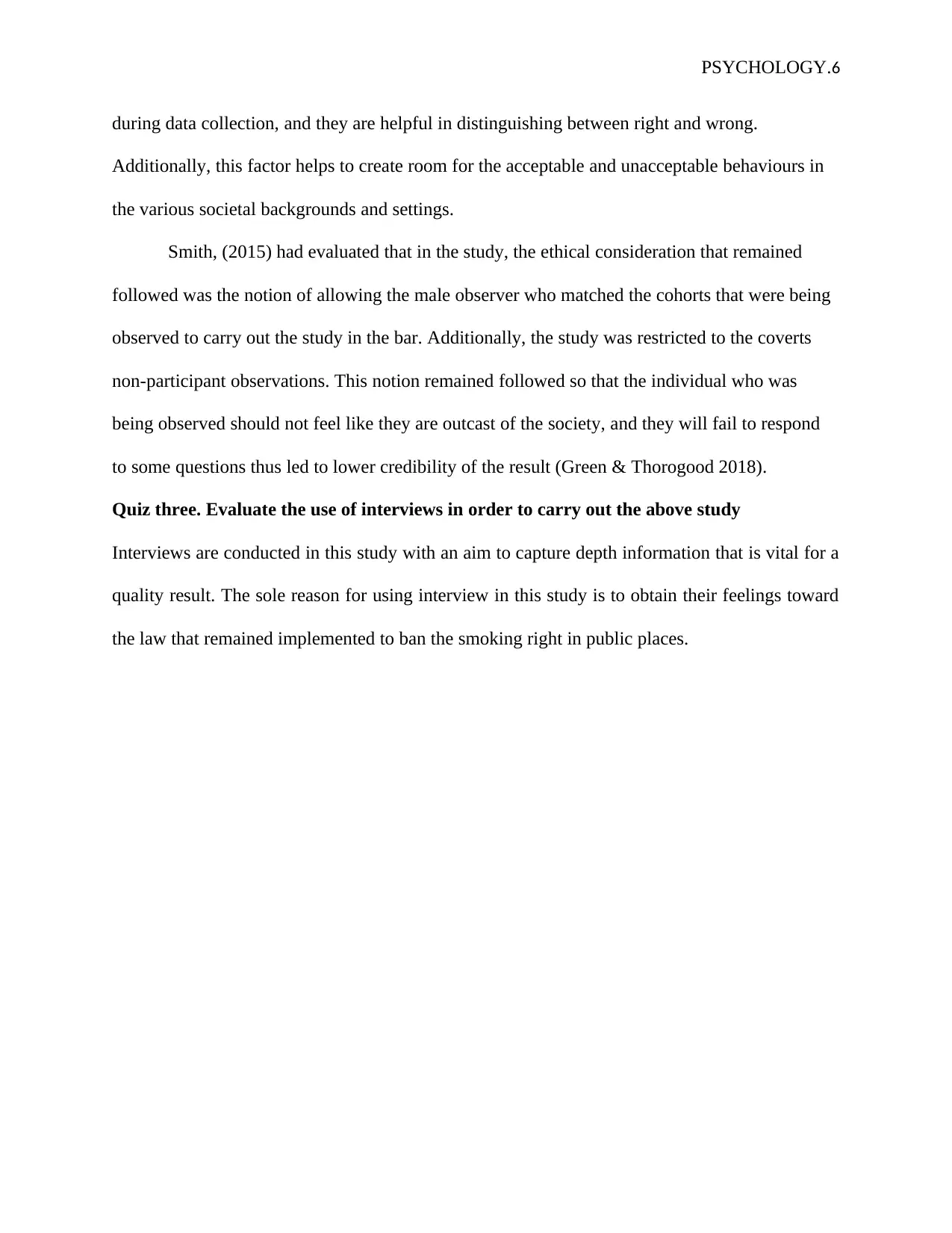
PSYCHOLOGY.6
during data collection, and they are helpful in distinguishing between right and wrong.
Additionally, this factor helps to create room for the acceptable and unacceptable behaviours in
the various societal backgrounds and settings.
Smith, (2015) had evaluated that in the study, the ethical consideration that remained
followed was the notion of allowing the male observer who matched the cohorts that were being
observed to carry out the study in the bar. Additionally, the study was restricted to the coverts
non-participant observations. This notion remained followed so that the individual who was
being observed should not feel like they are outcast of the society, and they will fail to respond
to some questions thus led to lower credibility of the result (Green & Thorogood 2018).
Quiz three. Evaluate the use of interviews in order to carry out the above study
Interviews are conducted in this study with an aim to capture depth information that is vital for a
quality result. The sole reason for using interview in this study is to obtain their feelings toward
the law that remained implemented to ban the smoking right in public places.
during data collection, and they are helpful in distinguishing between right and wrong.
Additionally, this factor helps to create room for the acceptable and unacceptable behaviours in
the various societal backgrounds and settings.
Smith, (2015) had evaluated that in the study, the ethical consideration that remained
followed was the notion of allowing the male observer who matched the cohorts that were being
observed to carry out the study in the bar. Additionally, the study was restricted to the coverts
non-participant observations. This notion remained followed so that the individual who was
being observed should not feel like they are outcast of the society, and they will fail to respond
to some questions thus led to lower credibility of the result (Green & Thorogood 2018).
Quiz three. Evaluate the use of interviews in order to carry out the above study
Interviews are conducted in this study with an aim to capture depth information that is vital for a
quality result. The sole reason for using interview in this study is to obtain their feelings toward
the law that remained implemented to ban the smoking right in public places.
⊘ This is a preview!⊘
Do you want full access?
Subscribe today to unlock all pages.

Trusted by 1+ million students worldwide
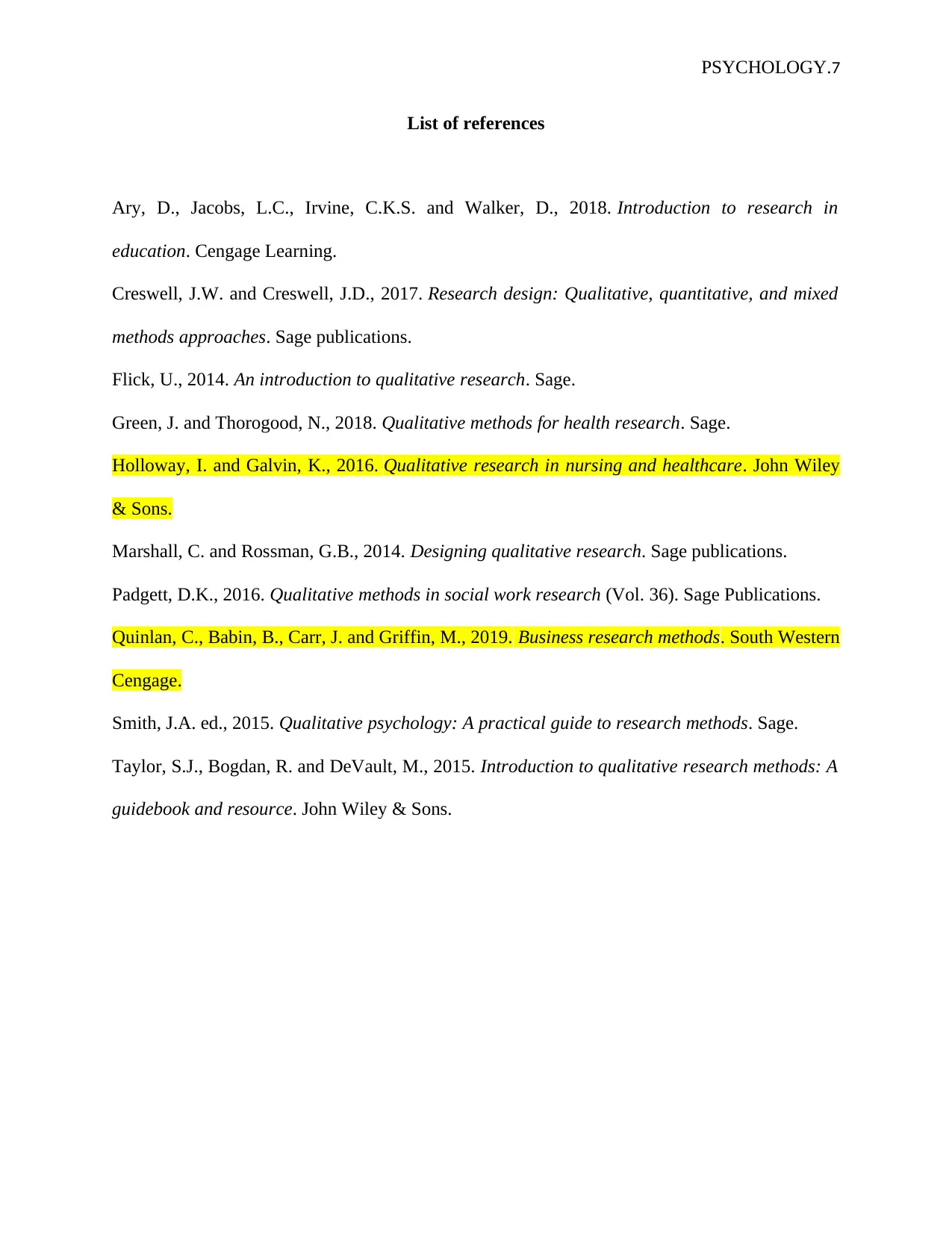
PSYCHOLOGY.7
List of references
Ary, D., Jacobs, L.C., Irvine, C.K.S. and Walker, D., 2018. Introduction to research in
education. Cengage Learning.
Creswell, J.W. and Creswell, J.D., 2017. Research design: Qualitative, quantitative, and mixed
methods approaches. Sage publications.
Flick, U., 2014. An introduction to qualitative research. Sage.
Green, J. and Thorogood, N., 2018. Qualitative methods for health research. Sage.
Holloway, I. and Galvin, K., 2016. Qualitative research in nursing and healthcare. John Wiley
& Sons.
Marshall, C. and Rossman, G.B., 2014. Designing qualitative research. Sage publications.
Padgett, D.K., 2016. Qualitative methods in social work research (Vol. 36). Sage Publications.
Quinlan, C., Babin, B., Carr, J. and Griffin, M., 2019. Business research methods. South Western
Cengage.
Smith, J.A. ed., 2015. Qualitative psychology: A practical guide to research methods. Sage.
Taylor, S.J., Bogdan, R. and DeVault, M., 2015. Introduction to qualitative research methods: A
guidebook and resource. John Wiley & Sons.
List of references
Ary, D., Jacobs, L.C., Irvine, C.K.S. and Walker, D., 2018. Introduction to research in
education. Cengage Learning.
Creswell, J.W. and Creswell, J.D., 2017. Research design: Qualitative, quantitative, and mixed
methods approaches. Sage publications.
Flick, U., 2014. An introduction to qualitative research. Sage.
Green, J. and Thorogood, N., 2018. Qualitative methods for health research. Sage.
Holloway, I. and Galvin, K., 2016. Qualitative research in nursing and healthcare. John Wiley
& Sons.
Marshall, C. and Rossman, G.B., 2014. Designing qualitative research. Sage publications.
Padgett, D.K., 2016. Qualitative methods in social work research (Vol. 36). Sage Publications.
Quinlan, C., Babin, B., Carr, J. and Griffin, M., 2019. Business research methods. South Western
Cengage.
Smith, J.A. ed., 2015. Qualitative psychology: A practical guide to research methods. Sage.
Taylor, S.J., Bogdan, R. and DeVault, M., 2015. Introduction to qualitative research methods: A
guidebook and resource. John Wiley & Sons.
1 out of 7
Related Documents
Your All-in-One AI-Powered Toolkit for Academic Success.
+13062052269
info@desklib.com
Available 24*7 on WhatsApp / Email
![[object Object]](/_next/static/media/star-bottom.7253800d.svg)
Unlock your academic potential
Copyright © 2020–2025 A2Z Services. All Rights Reserved. Developed and managed by ZUCOL.





